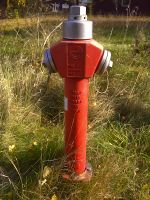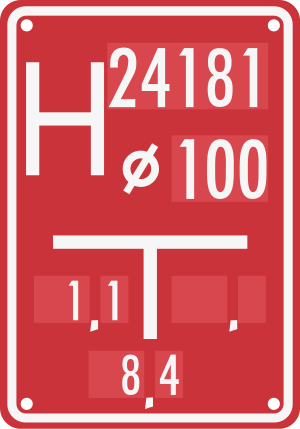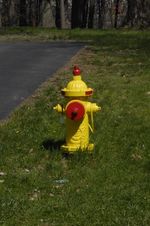Pl:Tag:emergency=fire_hydrant
(ratownictwo = hydrant) |
| Opis |
|---|
| Oznaczanie położenia hydrantu. |
| Grupa: Ratownictwo |
| Używane na tych elementach |
| Przydatne kombinacje |
| Status: zatwierdzony |
| Narzędzia |
emergency=fire_hydrant – służy do oznaczenia położenia hydrantu.
Opis obiektu
Hydrant (en: fire hydrant) jest częścią centralnego przeciwpożarowego systemu zaopatrzenia w wodę miast i miejscowości. System umożliwia straży pożarnej, ale także innym użytkownikom – instytucjom państwowym (np. utrzymanie dróg, przedsiębiorstwa miejskie) i prywatnym (np. sprzątanie ulic, organizacja festiwali) , pobieranie wody z publicznej sieci wodociągowej.
Mapa dla straży pożarnej
OpenFireMap pokazuje na całym świecie wszystkie siedziby straży pożarnej i hydranty. Ikonki na mapie są klikalne i pokazują w oknie pop-up wszystkie zebrane dane.
Mapowanie
Nanosimy węzeł ![]() w miejscu położenia hydrantu i dodajemy tag emergency=fire_hydrant
w miejscu położenia hydrantu i dodajemy tag emergency=fire_hydrant
Dodatkowe tagi
- fire_hydrant:type=underground/pillar/wall/pond (Typ: Hydrant podziemny / Hydrant nadziemny / Hydrant naścienny / Zbiornik poboru wody gasniczej – miejsce poboru wody)
- fire_hydrant:diameter=# (Średnica rury biegnącej pod ziemią wzdłuż ulicy, podana w mm. Nie mylić z średnicą przyłączy – couplings:diameters=*) (opcjonalnie)
- fire_hydrant:pressure=#/suction (Ciśnienie robocze w barach / przewód ssący) (opcjonalnie)
- ref=* (opcjonalnie)
- name=* (opcjonalnie)
- fire_hydrant:position=lane/parking_lot/sidewalk/green (Jezdnia / teren parkingu gdzie zatrzymują się pojazdy / chodnik / trawnik lub łąka) (opcjonalnie)
- fire_hydrant:count=# (opcjonalnie)
Atrybuty
- 1. Typ hydrantu
- fire_hydrant:type=underground/pillar/wall/pond
underground pillar wall pond Hydrant podziemny Hydrant nadziemny Hydrant naścienny Podłączenie do jeziora / rzeki (nazwa zwyczajowa "Suchy Hydrant" ) 




- 2. Średnica rury
- fire_hydrant:diameter=* (50, 80, 100, 150, 300, 400)
- patrz szyld poz. 2, lub na hydrancie np. "DN80"
- 3. Ciśnienie
- fire_hydrant:pressure=#/suction (Ciśnienie robocze w barach / przewód ssący)
- standardowo ciśnienie robocze w polskich sieciach to 8bar.
- 4. Oznaczenia
- name=*
- ref=* (na tabliczce orientacyjnej pierwsze oznaczenie od góry po prawej)
- fire_hydrant:count=# (jeśli istnieje więcej niż jeden hydrant)
- 5. Położenie(względne)
- fire_hydrant:position=lane/parking_lot/sidewalk/green
Atrybut Znaczenie lane jezdnia parking_lot teren parkingu na którym parkują pojazdy sidewalk chodnik green łąka
Inne
Polskie normy
PN-86/B-09700 – polska norma oznakowania hydrantów.
Tablica orientacyjna dla hydrantu: [1]
Ważne dla mapowania są TYLKO dwie pierwsze pozycje od góry. Pierwsza od góry to numer (ref) – druga to średnica.
Pozostałe cyfry oznaczają pozycję zaworu względem tabliczki.
Są potrzebne strażakom do odnalezienia zaworu – ale nie muszą znajdować się w bazie OSM.
Średnice hydrantów w Polsce
- w mieście wszystkie hydranty w ziemi (zasuwa żeliwna) są średnicy 80 mm – na to przychodzi stojak hydrantowy (pierwsze zdjęcie od góry).
- Hydranty "słupki" też w większości są 80 mm.
- Hydranty 50 mm stosowane są w budynkach
- Hydranty 100/110 mm głównie w zakładach przemysłowych.
Importy
pl:Fire_hydrant/Poznan Baza hydrantów zewnętrznych miasta Poznania
Linki itp.
- Niem: jak znaleźć hydrant? wskazówki po polsku wkrótce
- Proposed features/Fire Hydrant (zintegrowane w niniejszy opis)
- Mapa pokazująca w OSM promień zasięgu hydrantu, np.75m: [2] (w Polsce przepisy budowlane nakazują budowę punktów hydrantowych na sieci wodociągowej co max. 150 m – a to jest już aż 8 odcinków W75 – popularnych węży)
Opcjonalne tagi
Wszystkie pozostałe znaczniki są opcjonalne, ale są przydatne do celów przeciwpożarowych. Jeśli nie znasz danych, po prostu nie używaj tych tagów.
| Tag | Opis | Ważne wartości |
|---|---|---|
| fire_hydrant:diameter=* | This is the nominal diameter of the flanged connection to the underground pipe that feeds the hydrant. In some countries you can read it on the pillar or on the signboard. | # (numeric value) in mm, inches or letters. |
| flow_rate=* | Nominal flow rate. If fire_hydrant:awwa_class=* is present, this tag is redundant. | # (numeric value) with unit of measure, in International System standard unit is m3/s. But for hydrants are preferable l/min (liters per minute), usgal/min (US gallons per minute), ukgal/min (UK gallons per minute), or m3/h (cubic meters per hour). e.g.: flow_rate=600 l/min. In France, a normalized fire hydrant needs to supply 120 m3 during two hours. In the US, this specification is in Gallons Per Minute. |
| fire_hydrant:awwa_class=* | In the US, classification per American Waterworks Association. If flow_rate=* is present, this tag is redundant. See tha table below for details. | AA, A, B, C |
| couplings=* | Number of couplings. | # (numeric value) |
| couplings:type=* | Coupling standard. | Bayonet, Barcelona, Guillemin, Klaue, Sprawny, Storz, UNI
More types are described at: https://en.wikipedia.org/wiki/Hose_coupling |
| couplings:diameters=* | Each coupling diameter, separated by semicolons. | #;#;# (numeric values). Always specify the unit of measure, normally use mm. For inches use ". In some countries characters A, B, C are used to specify the connector (Austria and Germany)
e.g.: taken this image & guessing diameters, this could result in: couplings:diameters=45 mm;45 mm;110 mm |
| pillar:type=* | For better description of pillar hydrants, in addition to fire_hydrant=pillar. See below for details. | dry_barrel, wet_barrel |
| water_source=* | The water source for the hydrant. | main, stream, river, canal, drain, ditch, pond, lake, water_tank, swimming_pool, groundwater, ...
"main" means a hydrant connected to a pipe which is fed by the local distribution network. |
| water_volume=* | Volume of the water reserve, applicable only to water tanks and swimming pools. | # (numeric value) in m3. If another unit of measure is used, specify it |
| survey:date=* | Date of the last site survey (this tag is not specific to fire hydrants). This means that someone observed the hydrant at this location on this date. This does not imply that a functional check was done at that time.
For the date of last functional check, another tag (not yet defined) will be necessary. |
yyyy-mm-dd |
| colour=* | The colour of the hydrant. Unless otherwise specified, the entire hydrant is this colour. | blue, green, yellow and red are the valid values in the AWWA scheme, but many jurisdictions do other things |
| bonnet:colour=* | Colour of the top section ("bonnet") of the fire hydrant if different from the colour tag value. | blue, green, yellow and red are the valid values in the AWWA scheme, but many jurisdictions do other things |
| cap:colour=* | Colour of the caps of the fire hydrant if different from the colour tag value. The caps are the covers over the hose openings. | blue, green, yellow and red are the valid values in the AWWA scheme, but many jurisdictions do other things. If caps are painted in more than one colour, list all colours separated by semicolons |
| reflective:colour=* | Colour of reflective material, if any (commonly stripes or bands around the barrel). | |
| disused:emergency=fire_hydrant | Hydrants are supposed to be in service by default. On the contrary, if the hydrant is out of service, use this tag. | |
| manufacturer=* | To retreive information from manufacturers' documentation (this tag is not specific to fire hydrants). | |
| model=* | To retreive information from manufacturers' documentation (this tag is not specific to fire hydrants). | |
| fire_hydrant:position=* | Description of the position | lane (on the side of a road lane), parking_lot (in a parking), sidewalk (on a sidewalk), green (in a grassy area) |
| fire_hydrant:count=* | Number of hydrants, if there are more than one. Anyway it would be preferable to tag each hydrant with its own node (according the policy "one feature = one node"). | # (numeric value) |
| fire_hydrant:style=* | For special designs. | wsh, ... |
| ref=* | Reference number, if applicable. | # (numeric value) |
| name=* | Name, if applicable. | |
| fire_hydrant:opening=* | Direction to open the valve. Indicated in the corner of the signage in Hungary with a round arrow. | cw (clockwise), ccw (counterclockwise) |
Wartości dla fire:hydrant:awwa_class
według American Water Works Association colour scheme:
Hydranty są zazwyczaj zasilane przez sieci wodociągowe na obszarach miejskich i podmiejskich. Wymiary sieci różnią się znacznie, a więc przepływ hydrantów może się znacznie różnić. Lokalizacja hydrantów jest pierwszym wymaganiem we wzajemnym wezwaniu pomocy; drugą najważniejszą informacją jest przepustowość. Niektóre jurysdykcje w Stanach Zjednoczonych dostosowały schemat kolorów określony przez American Water Works Association. W tych jurysdykcjach przepustowość może być określona po prostu przez sprawdzenie koloru maski i nakrętek hydrantu. W innych przypadkach ustalenie zdolności może być trudniejsze.
| Klasa | Przepływowość | Kolor Bonnet & Caps |
|---|---|---|
| AA | więcej niż 1500 US gal/min | Jasno niebieski |
| A | pomiędzy 1500 a 1000 US gal/min | Zielony |
| B | pomiędzy 1000 a 500 US gal/min | Żółty |
| C | mniej niż 500 US gal/min | Czerwony |
Wartości dla pillar:type
| Wartość | Opis | |
|---|---|---|
| dry_barrel | A style of pillar hydrant where the water shutoff valve is below ground, hopefully below the frost line. These are used on pressurized systems where freezing is a risk. They are occasionally used for dry hydrants when the water supply is higher in altitude than the hydrant.
The type may be determined by inspecting the caps: they are usually arrayed at the same level as there is no corresponding valve inside the hydrant barrel. The handle to operate the underground valve is ususally on the top (bonnet) of the hydrant. |
|
| wet_barrel | A style of pillar hydrant where the barrel is pressurized at all times, with individual valves for each outlet. These are common in temperate climates, but not used wherever the temperatures may be consistently below freezing.
The type may be determined by inspecting the caps: each cap has a valve internal to the hydrant barrel and the handle to operate it is usually opposite to the corresponding cap. The caps usually are not arrayed on the same level, but this peculiarity, if alone, is not enough to identify a wet barrel hydrant. |
Mapy wyświetlające hydranty
- http://mapa.abakus.net.pl/mapa/ – tylko Polska
- http://openfiremap.org/ – świat
- OSM Hydrant – narzędzie do wyświetlania, dodawania i edytowania hydrantów
- MapComplete.osm.be



